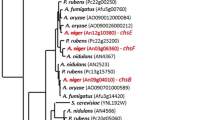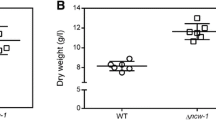Abstract
The common saprophyte Aspergillus niger may experience carbon starvation in nature as well as during industrial fermentations. Starvation survival strategies, such as conidiation or the formation of exploratory hyphae, require energy and building blocks, which may be supplied by autolysis. Glycoside hydrolases are key effectors of autolytic degradation of fungal cell walls, but knowledge on their identity and functionality is still limited. We recently identified agnB and cfcA as two genes encoding carbohydrate-active enzymes that had notably increased transcription during carbon starvation in A. niger. Here, we report the biochemical and functional characterization of these enzymes. AgnB is an α-1,3-glucanase that releases glucose from α-1,3-glucan substrates with a minimum degree of polymerization of 4. CfcA is a chitinase that releases dimers from the nonreducing end of chitin. These enzymes thus attack polymers that are found in the fungal cell wall and may have a role in autolytic fungal cell wall degradation in A. niger. Indeed, cell wall degradation during carbon starvation was reduced in the double deletion mutant ΔcfcA ΔagnB compared to the wild-type strain. Furthermore, the cell walls of the carbon-starved mycelium of the mutant contained a higher fraction of chitin or chitosan. The function of at least one of these enzymes, CfcA, therefore appears to be in the recycling of cell wall carbohydrates under carbon limiting conditions. CfcA thus may be a candidate effector for on demand cell lysis, which could be employed in industrial processes for recovery of intracellular products.







Similar content being viewed by others
References
Ait-Lahsen H, Soler A, Rey M, de La CJ, Monte E, Llobell A (2001) An antifungal exo-α-1,3-glucanase (AGN13.1) from the biocontrol fungus Trichoderma harzianum. Appl Environ Microbiol 67:5833–5839
Arentshorst M, Ram AF, Meyer V (2012) Using non-homologous end-joining-deficient strains for functional gene analyses in filamentous fungi. Methods Mol Biol 835:133–150
Bos CJ, Debets AJ, Swart K, Huybers A, Kobus G, Slakhorst SM (1988) Genetic analysis and the construction of master strains for assignment of genes to six linkage groups in Aspergillus niger. Curr Genet 14:437–443
Bradford MM (1976) A rapid and sensitive method for the quantitation of microgram quantities of protein utilizing the principle of protein-dye binding. Anal Biochem 72:248–254
de Bekker C, Wiebenga A, Aguilar G, Wösten HA (2009) An enzyme cocktail for efficient protoplast formation in Aspergillus niger. J Microbiol Methods 76:305–306
Dekker N, Speijer D, Grun CH, van den Berq M, de Haan A, Hochstenbach F (2004) Role of the α-glucanase Agn1p in fission-yeast cell separation. Mol Biol Cell 15:3903–3914
Dekker N, van Rijssel J, Distel B, Hochstenbach F (2007) Role of the α-glucanase Agn2p in ascus-wall endolysis following sporulation in fission yeast. Yeast 24:279–288
Emri T, Molnar Z, Szilagyi M, Pocsi I (2008) Regulation of autolysis in Aspergillus nidulans. Appl Biochem Biotechnol 151:211–220
Erdei E, Pusztahelyi T, Miskei M, Barna T, Pocsi I (2008) Characterization and heterologous expression of an age-dependent fungal/bacterial type chitinase of Aspergillus nidulans. Acta Microbiol Immunol Hung 55:351–361
Escott GM, Hearn VM, Adams DJ (1998) Inducible chitinolytic system of Aspergillus fumigatus. Microbiology 144:1575–1581
Fontaine T, Simenel C, Dubreucq G, Adam O, Delepierre M, Lemoine J, Vorgias CE, Diaquin M, Latgé JP (2000) Molecular organization of the alkali-insoluble fraction of Aspergillus fumigatus cell wall. J Biol Chem 275:27594–27607
Fuglsang CC, Berka RM, Wahleithner JA, Kauppinen S, Shuster JR, Rasmussen G, Halkier T, Dalbøge H, Henrissat B (2000) Biochemical analysis of recombinant fungal mutanases. A new family of α-1,3-glucanases with novel carbohydrate-binding domains. J Biol Chem 275:2009–2018
Fukamizo T, Hayashi K (1982) Separation and mutarotation of anomers of chitooligosaccharides. J Biochem 91:619–626
Fukamizo T, Sasaki C, Schelp E, Bortone K, Robertus JD (2001) Kinetic properties of chitinase-1 from the fungal pathogen Coccidioides immitis. Biochemistry 40:2448–2454
García I, Jiménez D, Martín V, Durán A, Sánchez Y (2005) The α-glucanase Agn1p is required for cell separation in Schizosaccharomyces pombe. Biol Cell 97:569–576
Grün CH (2003) Structure and biosynthesis of fungal α-glucans. PhD thesis, University of Utrecht, Utrecht, The Netherlands
Grün CH, Dekker N, Nieuwland AA, Klis FM, Kamerling JP, Vliegenthart JF, Hochstenbach F (2006) Mechanism of action of the endo-(1–3)-α-glucanase MutAp from the mycoparasitic fungus Trichoderma harzianum. FEBS Lett 580:3780–3786
Heuts DP, van Hellemond EW, Janssen DB, Fraaije MW (2007) Discovery, characterization, and kinetic analysis of an alditol oxidase from Streptomyces coelicolor. J Biol Chem 282:20283–20291
Hrdlicka PJ, Sørensen AB, Poulsen BR, Ruijter GJ, Visser J, Iversen JJ (2004) Characterization of nerolidol biotransformation based on indirect on-line estimation of biomass concentration and physiological state in batch cultures of Aspergillus niger. Biotechnol Prog 20:368–376
Jaques AK, Fukamizo T, Hall D, Barton RC, Escott GM, Parkinson T, Hitchcock CA, Adams DJ (2003) Disruption of the gene encoding the ChiB1 chitinase of Aspergillus fumigatus and characterization of a recombinant gene product. Microbiology 149:2931–2939
Johnston IR (1965) The composition of the cell wall of Aspergillus niger. Biochem J 96:651–658
Kralj S, van Geel-Schutten GH, Dondorff MM, Kirsanovs S, van der Maarel MJ, Dijkhuizen L (2004) Glucan synthesis in the genus Lactobacillus: isolation and characterization of glucansucrase genes, enzymes and glucan products from six different strains. Microbiology 150:3681–3690
Li B, Dobruchowska JM, Hoogenkamp MA, Gerwig GJ (2012) Structural investigation of an extracellular polysaccharide produced by the cariogenic bacterium Streptococcus mutans strain UA159. Carbohydr Polym 90:675–682
Lu Y, Yang H, Hu H, Wang Y, Rao Z, Jin C (2009) Mutation of Trp137 to glutamate completely removes transglycosyl activity associated with the Aspergillus fumigatus AfChiB1. Glycoconj J 26:525–534
Maubon D, Park S, Tanguy M, Huerre M, Schmitt C, Prevost MC, Perlin DS, Latgé JP, Beauvais A (2006) AGS3, an α(1–3)glucan synthase gene family member of Aspergillus fumigatus, modulates mycelium growth in the lung of experimentally infected mice. Fungal Genet Biol 43:366–375
Nitsche BM, Jorgensen TR, Akeroyd M, Meyer V, Ram AF (2012) The carbon starvation response of Aspergillus niger during submerged cultivation: insights from the transcriptome and secretome. BMC Genomics 13:380
Ram AF, Klis FM (2006) Identification of fungal cell wall mutants using susceptibility assays based on Calcofluor white and Congo red. Nat Protoc 1:2253–2256
Rocklin RD, Clarke AP, Weitzhandler M (1998) Improved long-term reproducibility for pulsed amperometric detection of carbohydrates via a new quadruple-potential waveform. Anal Chem 70:1496–1501
Sambrook J, Frisch EF, Maniatis T (1989) Molecular cloning: a laboratory manual. Cold Spring Harbor Laboratory, Cold Spring Harbor, NY
Sanz L, Montero M, Redondo J, Llobell A, Monte E (2005) Expression of an α-1,3-glucanase during mycoparasitic interaction of Trichoderma asperellum. FEBS J 272:493–499
Shalom G, Pratten J, Wilson M, Nair SP (2008) Cloning, heterologous gene expression and biochemical characterization of the α-1,3-glucanase from the filamentous fungus Penicillium purpurogenum. Protein Expr Purif 60:170–175
Shin KS, Kwon NJ, Kim YH, Park HS, Kwon GS, Yu JH (2009) Differential roles of the ChiB chitinase in autolysis and cell death of Aspergillus nidulans. Eukaryot Cell 8:738–746
Szilágyi M, Kwon NJ, Dorogi C, Pócsi I, Yu JH, Emri T (2010) The extracellular β-1,3-endoglucanase EngA is involved in autolysis of Aspergillus nidulans. J Appl Microbiol 109:1498–1508
Szilágyi M, Miskei M, Karányi Z, Lenkey B, Pócsi I, Emri T (2013) Transcriptome changes initiated by carbon starvation in Aspergillus nidulans. Microbiology 159:176–190
Terwisscha van Scheltinga AC, Armand S, Kalk KH, Isogai A, Henrissat B, Dijkstra BW (1995) Stereochemistry of chitin hydrolysis by a plant chitinase/lysozyme and X-ray structure of a complex with allosamidin: evidence for substrate assisted catalysis. Biochemistry 34:15619–15623
van Hartingsveldt W, Mattern IE, van Zeijl CM, Pouwels PH, van den Hondel CA (1987) Development of a homologous transformation system for Aspergillus niger based on the pyrG gene. Mol Gen Genet 206:71–75
van Leeuwen SS, Kralj S, van Geel-Schutten IH, Gerwig GJ, Dijkhuizen L, Kamerling JP (2008) Structural analysis of the α-D-glucan (EPS180) produced by the Lactobacillus reuteri strain 180 glucansucrase GTF180 enzyme. Carbohydr Res 343:1237–1250
van Munster JM, van der Kaaij RM, Dijkhuizen L, van der Maarel MJEC (2012) Biochemical characterization of Aspergillus niger CfcI, a glycoside hydrolase family 18 chitinase that releases monomers during substrate hydrolysis. Microbiology 158:2168–2179
van Munster JM, Nitsche BM, Krijgsheld P, van Wijk A, Dijkhuizen L, Wösten HA, Ram AF, van der Maarel MJ (2013) Chitinases CtcB and CfcI modify the cell wall in sporulating aerial mycelium of Aspergillus niger. Microbiology 159:1853–1867
Ward OP, Qin WM, Dhanjoon J, Ye J, Singh A (2006) Physiology and biotechnology of Aspergillus. Adv Appl Microbiol 58:1–75
Wei H, Scherer M, Singh A, Liese R, Fischer R (2001) Aspergillus nidulans α-1,3 glucanase (mutanase), mutA, is expressed during sexual development and mobilizes mutan. Fungal Genet Biol 34:217–227
White S, McIntyre M, Berry DR, McNeil B (2002) The autolysis of industrial filamentous fungi. Crit Rev Biotechnol 22:1–14
Wiater A, Szczodrak J, Rogalski J (2001) Purification and characterization of an extracellular mutanase from Trichoderma harzianum. Mycol Res 105:1357–1363
Xia G, Jin C, Zhou J, Yang S, Zhang S, Jin C (2001) A novel chitinase having a unique mode of action from Aspergillus fumigatus YJ-407. Eur J Biochem 268:4079–4085
Yamazaki H, Yamazaki D, Takaya N, Takagi M, Ohta A, Horiuchi H (2007) A chitinase gene, chiB, involved in the autolytic process of Aspergillus nidulans. Curr Genet 51:89–98
Zonneveld BJ (1972a) A new type of enzyme, an exo-splitting α-1,3-glucanase from non-induced cultures of Aspergillus nidulans. Biochim Biophys Acta 258:541–547
Zonneveld BJ (1972b) Morphogenesis in Aspergillus nidulans. The significance of an α-1,3-glucan of the cell wall and α-1,3-glucanase for cleistothecium development. Biochim Biophys Acta 273:174–187
Acknowledgments
We thank A. van Wijk (University of Groningen, the Netherlands) for excellent technical assistance with analysis of the cell wall monomer composition. We thank Kerry BV (the Netherlands) for performing protease activity assays. We acknowledge B. M. Nitsche (University of Leiden, the Netherlands) for supplying vectors pDONR221-PgpdA-hpH-TtrpC and pDONR221-AOpyrG and B. J. Zonneveld (University of Leiden, the Netherlands) for supplying the alkaline-soluble fraction of A. nidulans cell walls.
Author information
Authors and Affiliations
Corresponding author
Rights and permissions
About this article
Cite this article
van Munster, J.M., Dobruchowska, J.M., Veloo, R. et al. Characterization of the starvation-induced chitinase CfcA and α-1,3-glucanase AgnB of Aspergillus niger . Appl Microbiol Biotechnol 99, 2209–2223 (2015). https://doi.org/10.1007/s00253-014-6062-3
Received:
Revised:
Accepted:
Published:
Issue Date:
DOI: https://doi.org/10.1007/s00253-014-6062-3




